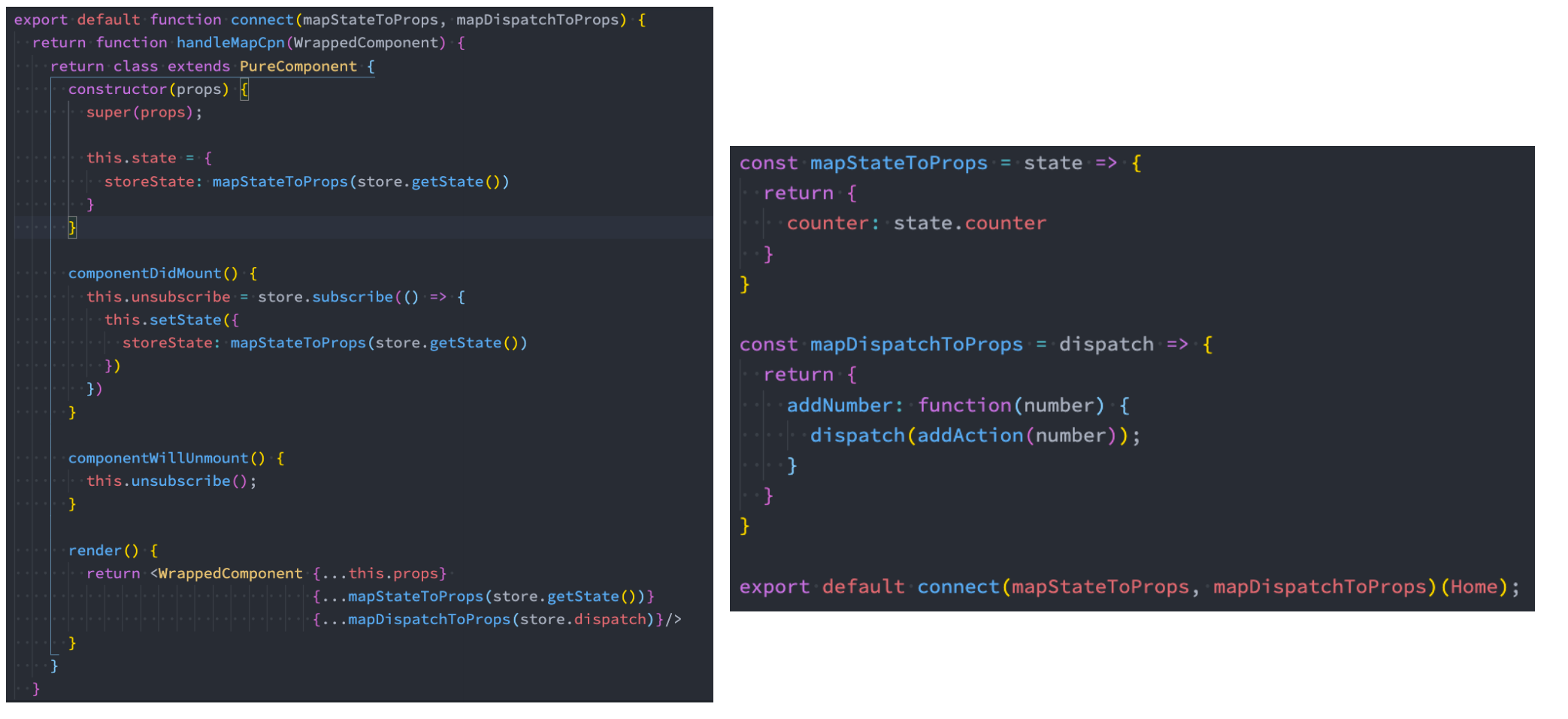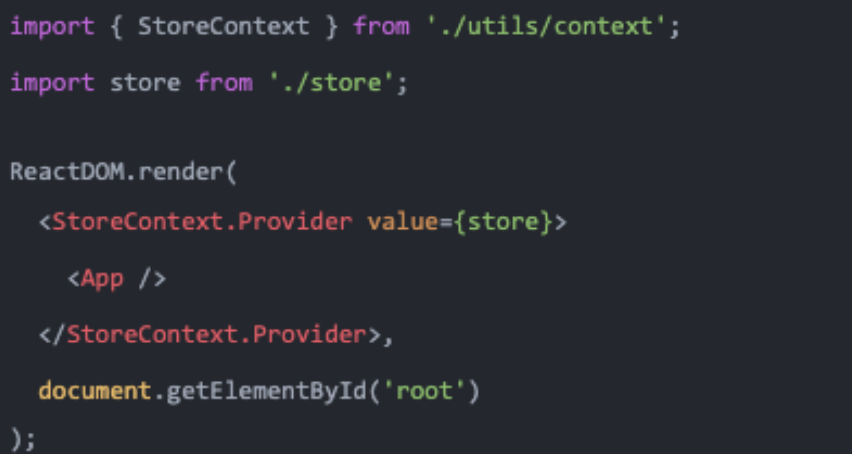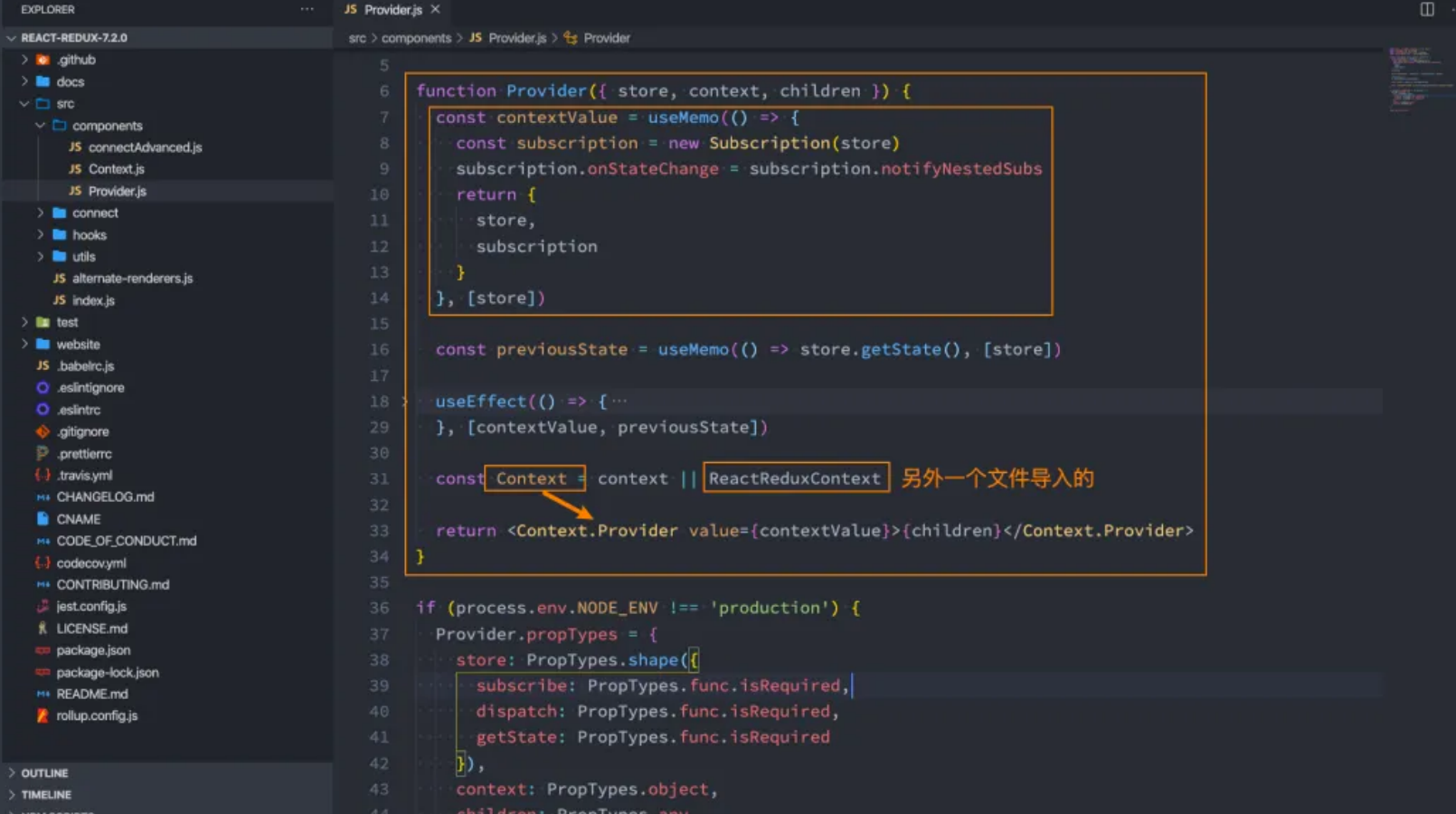♠ react-redux的使用
redux融入react代码#
手动和redux联系#
在 componentDidMount 中定义数据的变化,当数据发生变化时重新设置 counter;在发生点击事件时,调用store的dispatch来派发对应的action;
查看代码
//手动和redux联系
import React, { PureComponent } from 'react';
import store from '../store';
import {
subAction
} from "../store/actionCreators";
export default class About extends PureComponent {
constructor(props) {
super(props);
this.state = {
counter: store.getState().counter
}
}
componentDidMount() {
this.unsubscribue = store.subscribe(() => {
this.setState({
counter: store.getState().counter
})
})
}
componentWillUnmount() {
this.unsubscribue();
}
render() {
return (
<div>
<hr />
<h1>About</h1>
<h2>当前计数: {this.state.counter}</h2>
<button onClick={e => this.decrement()}>-1</button>
<button onClick={e => this.subNumber(5)}>-5</button>
</div>
)
}
decrement() {
store.dispatch(subAction(1));
}
subNumber(num) {
store.dispatch(subAction(num));
}
}自定义connect函数#
把手动订阅和取消订阅抽离到connect中
查看代码
import React, { PureComponent } from 'react';
import {connect} from '../utils/connect';
import {
incAction,
addAction
} from '../store/actionCreators'
class Home extends PureComponent {
render() {
return (
<div>
<h1>Home</h1>
<h2>当前计数: {this.props.counter}</h2>
<button onClick={e => this.props.increment()}>+1</button>
<button onClick={e => this.props.addNumber(5)}>+5</button>
</div>
)
}
}
const mapStateToProps = state => ({
counter: state.counter
})
const mapDispatchToProps = dispatch => ({
increment() {
dispatch(incAction());
},
addNumber(num) {
dispatch(addAction(num));
}
})
export default connect(mapStateToProps, mapDispatchToProps)(Home);但是上面的connect函数有一个很大的缺陷:依赖导入的store,如果我们将其封装成一个独立的库,需要依赖用于创建的store,我们应该如何去获取呢?难道让用户来修改我们的源码吗?不太现实;正确的做法是我们提供一个Provider,Provider来自于我们创建的Context,让用户将store传入到value中即可;
查看代码
import React, { PureComponent } from "react";
import { StoreContext } from './context';
export function connect(mapStateToProps, mapDispachToProp) {
return function enhanceHOC(WrappedComponent) {
class EnhanceComponent extends PureComponent {
constructor(props, context) {
super(props, context);
this.state = {
storeState: mapStateToProps(context.getState())
}
}
componentDidMount() {
this.unsubscribe = this.context.subscribe(() => {
this.setState({
storeState: mapStateToProps(this.context.getState())
})
})
}
componentWillUnmount() {
this.unsubscribe();
}
render() {
return <WrappedComponent {...this.props}
{...mapStateToProps(this.context.getState())}
{...mapDispachToProp(this.context.dispatch)} />
}
}
EnhanceComponent.contextType = StoreContext;
return EnhanceComponent;
}
}react-redux使用#
开始之前需要强调一下,redux和react没有直接的关系,你完全可以在React, Angular, Ember, jQuery, or vanilla JavaScript中使用Redux。虽然我们之前已经实现了connect、Provider这些帮助我们完成连接redux、react的辅助工具,但是实际上redux官方帮助我们提供了 react-redux 的库,可以直接在项目中使用,并且实现的逻辑会更加的严谨和高效。
安装react-redux:yarn add react-redux
react-redux源码导读
组件中异步操作#
我们可以直接通过同步的操作来dispatch action,state就会被立即更新。但是真实开发中,redux中保存的很多数据可能来自服务器,我们需要进行异步的请求,再将数据保存到redux中。网络请求可以在class组件的componentDidMount中发送,所以我们可以有这样的结构:
上面的代码有一个缺陷:
- 我们必须将网络请求的异步代码放到组件的生命周期中来完成;
- 事实上,网络请求到的数据也属于我们状态管理的一部分,更好的一种方式应该是将其也交给redux来管理;
但是在redux中如何可以进行异步的操作呢?答案就是使用中间件(Middleware);学习过Express或Koa框架的童鞋对中间件的概念一定不陌生;在这类框架中,Middleware可以帮助我们在请求和响应之间嵌入一些操作的代码,比如cookie解析、日志记录、文件压缩等操作;
redux也引入了中间件(Middleware)的概念:
- 这个中间件的目的是在dispatch的action和最终达到的reducer之间,扩展一些自己的代码;
- 比如日志记录、调用异步接口、添加代码调试功能等等;
我们现在要做的事情就是发送异步的网络请求,所以我们可以添加对应的中间件:这里官网推荐的、包括演示的网络请求的中间件是使用 redux-thunk;
redux-thunk是如何做到让我们可以发送异步的请求呢?
- 我们知道,默认情况下的dispatch(action),action需要是一个JavaScript的对象;
- redux-thunk可以让dispatch(action函数),action可以是一个函数;
- 该函数会被调用,并且会传给这个函数一个dispatch函数和getState函数;
- dispatch函数用于我们之后再次派发action;
- getState函数考虑到我们之后的一些操作需要依赖原来的状态,用于让我们可以获取之前的一些状态;
如何使用redux-thunk
1.安装redux-thunk,yarn add redux-thunk
2.在创建store时传入应用了middleware的enhance函数
- 通过applyMiddleware来结合多个Middleware, 返回一个enhancer;
- 将enhancer作为第二个参数传入到createStore中;
redux-devtools
redux可以方便的让我们对状态进行跟踪和调试,那么如何做到呢?
redux官网为我们提供了redux-devtools的工具;
利用这个工具,我们可以知道每次状态是如何被修改的,修改前后的状态变化等等;
安装该工具需要两步:
- 第一步:在对应的浏览器中安装相关的插件(比如Chrome浏览器扩展商店中搜索Redux DevTools即可,其他方法可以参考GitHub);
- 第二步:在redux中继承devtools的中间件;
查看代码
import { createStore, applyMiddleware, compose } from 'redux';
import thunkMiddleware from 'redux-thunk';
import createSagaMiddleware from 'redux-saga';
import saga from './saga';
import reducer from './reducer.js';
// composeEnhancers函数
const composeEnhancers = window.__REDUX_DEVTOOLS_EXTENSION_COMPOSE__({trace: true}) || compose;
// 应用一些中间件
// 1.引入thunkMiddleware中间件(上面)
// 2.创建sagaMiddleware中间件
const sagaMiddleware = createSagaMiddleware();
const storeEnhancer = applyMiddleware(thunkMiddleware, sagaMiddleware);
const store = createStore(reducer, composeEnhancers(storeEnhancer));
sagaMiddleware.run(saga);
export default store;















【推荐】国内首个AI IDE,深度理解中文开发场景,立即下载体验Trae
【推荐】编程新体验,更懂你的AI,立即体验豆包MarsCode编程助手
【推荐】抖音旗下AI助手豆包,你的智能百科全书,全免费不限次数
【推荐】轻量又高性能的 SSH 工具 IShell:AI 加持,快人一步
· 阿里最新开源QwQ-32B,效果媲美deepseek-r1满血版,部署成本又又又降低了!
· Manus重磅发布:全球首款通用AI代理技术深度解析与实战指南
· 开源Multi-agent AI智能体框架aevatar.ai,欢迎大家贡献代码
· 被坑几百块钱后,我竟然真的恢复了删除的微信聊天记录!
· AI技术革命,工作效率10个最佳AI工具